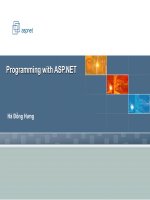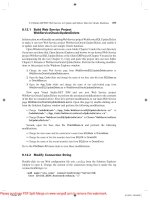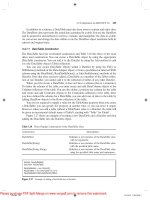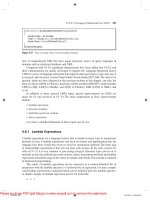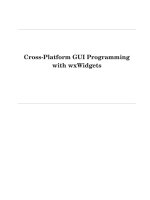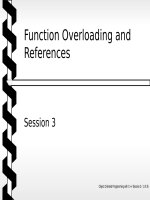C++ GUI Programming with Qt 3 ppt
Bạn đang xem bản rút gọn của tài liệu. Xem và tải ngay bản đầy đủ của tài liệu tại đây (7.02 MB, 464 trang )
C
++
GUI Programming
with Qt 3
B
RUCE
P
ERENS
’ O
PEN
S
OURCE
S
ERIES
◆
C++ GUI Programming with Qt 3
Jasmin Blanchette, Mark Summerfield
◆
Managing Linux Systems with Webmin: System
Administration and Module Development
Jamie Cameron
◆ Understanding the Linux Virtual Memory Manager
Mel Gorman
◆ Implementing CIFS: The Common Internet File System
Christopher R. Hertel
◆ Embedded Software Development with eCos
Anthony J. Massa
◆ Rapid Application Development with Mozilla
Nigel McFarlane
◆ The Linux Development Platform: Configuring, Using,
and Maintaining a Complete Programming
Environment
Rafeeq Ur Rehman, Christopher Paul
◆
Intrusion Detection Systems with Snort:
Advanced IDS Techniques with Snort, Apache,
MySQL, PHP, and ACID
Rafeeq Ur Rehman
◆
The Official Samba-3 HOWTO and Reference Guide
John H. Terpstra, Jelmer R. Vernooij, Editors
C
++
GUI Programming
with Qt 3
Jasmin Blanchette
Mark Summerfield
Prentice Hall in association with Trolltech Press
Library of Congress Cataloging-in-Publication Data
A CIP catalog record for this book can be obtained from the Library of Congress
Editorial/Production Supervision: Kathleen M. Caren
Cover Design Director: Jerry Votta
Art Director: Gail Cocker-Bogusz
Manufacturing Buyer: Maura Zaldivar
Acquisitions Editor: Jill Harry
Editorial Assistant: Brenda Mulligan
Marketing Manager: Dan Depasquale
Copyright
2004 Trolltech AS
Published by Pearson Education, Inc.
Publishing as Prentice Hall Professional Technical Reference
Upper Saddle River, New Jersey 07458
This material may only be distributed subject to the terms and conditions set forth in the
Open Publication License, v1.0 or later (the latest version is available at
n-
content.org/openpub/
).
Prentice Hall PTR offers excellent discounts on this book when ordered in quanti-
ty for bulk purchases or special sales. For more information, please contact: U.S.
Corporate and Government Sales, 1-800-382-3419, corpsales@pearsontechgroup.
com. For sales outside of the U.S., please contact: International Sales, 1-317-581-
3793,
Trolltech
,Qt
, and the Trolltech logo are registered trademarks of Trolltech. OpenGL
is a trademark of Silicon Graphics, Inc. in the United States and other countries. All
other company and product names mentioned herein are the trademarks or registered
trademarks of their respective owners.
The authors,copyright holder, and publisher have taken care in the preparation of this book,
but make no expressed or implied warranty of any kind and assume no responsibility for
errors or omissions. The information in this book is furnished for informational use only, is
subject to change without notice, and does not represent a commitment on the part of the
copyright holder or the publisher. No liability is assumed for incidental or consequential
damages in connection with or arising out of the use of the information or programs
contained herein.
The software described in this book is furnished under a license agreement or non-disclosure
agreement. The software may be used or copied only in accordance with the terms of the
agreement.
Printed in the United States of America
First Printing
ISBN 0-13-124072-2
Pearson Education Ltd.
Pearson Education Australia Pty., Limited
Pearson Education Singapore, Pte. Ltd.
Pearson Education North Asia Ltd.
Pearson Education Canada, Ltd.
Pearson Educación de Mexico, S.A. de C.V.
Pearson Education-Japan
Pearson Education Malaysia, Pte. Ltd.
Contents
Foreword
ix
Preface
xi
Acknowledgments
xiii
A Brief History of Qt
xv
Part I: Basic Qt
1
.
Getting Started
3
Hello Qt 3
Making Connections 5
Using the Reference Documentation 8
2
.
Creating Dialogs
11
Subclassing QDialog 11
Signals and Slots in Depth 18
Rapid Dialog Design 21
Shape-Changing Dialogs 28
Dynamic Dialogs 33
Built-in Widget and Dialog Classes 33
3
.
Creating Main Windows
39
Subclassing QMainWindow 40
Creating Menus and Toolbars 44
Implementing the File Menu 49
Setting Up the Status Bar 56
Using Dialogs 58
Storing Settings 63
Multiple Documents 64
Splash Screens 67
v
4
.
Implementing Application Functionality
69
The Central Widget 69
Subclassing QTable 70
Loading and Saving 77
Implementing the Edit Menu 80
Implementing the Other Menus 84
Subclassing QTableItem 88
5
.
Creating Custom Widgets
97
Customizing Qt Widgets 97
Subclassing QWidget 99
Integrating Custom Widgets with Qt Designer 108
Double Buffering 112
Part II: Intermediate Qt
6
.
Layout Management
135
Basic Layouts 135
Splitters 140
Widget Stacks 144
Scroll Views 145
Dock Windows 150
Multiple Document Interface 152
7
.
Event Processing
163
Reimplementing Event Handlers 163
Installing Event Filters 168
Staying Responsive During Intensive Processing 171
8
.
2D and 3D Graphics
175
Painting with QPainter 175
Graphics with QCanvas 185
Printing 198
Graphics with OpenGL 209
9
.
Drag and Drop
215
Enabling Drag and Drop 215
Supporting Custom Drag Types 220
Advanced Clipboard Handling 224
vi
10
.
Input/Output
227
Reading and Writing Binary Data 227
Reading and Writing Text 234
Handling Files and Directories 237
Inter-Process Communication 239
11
.
Container Classes
243
Vectors 243
Lists 247
Maps 249
Pointer-Based Containers 251
QString and QVariant 254
12
.
Databases
261
Connecting and Querying 261
Presenting Data in Tabular Form 266
Creating Data-Aware Forms 275
13
.
Networking
283
Using QFtp 283
Using QHttp 289
TCP Networking with QSocket 291
UDP Networking with QSocketDevice 301
14
.
XML
307
Reading XML with SAX 307
Reading XML with DOM 312
Writing XML 316
15
.
Internationalization
319
Working with Unicode 319
Making Applications Translation-Aware 323
Dynamic Language Switching 329
Translating Applications 334
16
.
Providing Online Help
339
Tooltips, Status Tips, and “What’s This?” Help 339
Using QTextBrowser as a Simple Help Engine 342
Using Qt Assistant for Powerful Online Help 346
vii
17
.
Multithreading
349
Working with Threads 349
Communicating with the GUI Thread 359
Using Qt’s Classes in Non-GUI Threads 363
18
.
Platform-Specific Features
367
Interfacing with Native APIs 367
Using ActiveX 371
Session Management 384
Appendices
A
.
Installing Qt
393
A Note on Licensing 393
Installing Qt/Windows 394
Installing Qt/Mac 395
Installing Qt/X11 397
B
.
Qt’s Class Hierarchy
399
Index
403
viii
Foreword
Why Qt? Why do programmers like us choose Qt? Sure, there are the obvious
answers: Qt’s single-source compatibility, its feature richness, its C
++
perfor-
mance, the availability of the source code, its documentation, the high-quality
technical support, and all the other items mentioned in Trolltech’s glossy mar-
keting materials. This is all very well, but it misses the most important point:
Qt is successful because programmers like it.
How come programmers like one technology, but dislike another? Personally,
I believe software engineers enjoy technology that feels right, but dislike ev-
erything that doesn’t. How else can we explain that some of the brightest pro-
grammers need help to program a VCR, or that most engineers seem to have
trouble operating the company’s phone system? I for one am perfectly capa-
ble of memorizing sequences of random numbers and commands, but if these
are required to control my answering machine, I’d prefer not to have one. At
Trolltech, our phone system forces us to hold the ‘
∗
’ key pressed down for two
seconds before we are allowed to type in the other person’s extension number.
If you forget to do this but start typing the extension immediately, you have
to dial the entire number again. Why ‘
∗
’? Why not ‘#’, or ‘1’, or ‘5’, or any of
the other twenty keys on the phone? Why two seconds and not one, or three,
or one and a half? Why anything at all? I find the phone so irritating that I
avoid using it whenever I can. Nobody likes having to do random things, espe-
cially when those random things apparently depend on some equally random
context you wish you didn’t have to know about in the first place.
Programming can be a lot like using our phone system, only worse. And this
is where Qt comes to the rescue. Qt is different. For one thing, Qt makes sense.
And for another, Qt is fun. Qt lets you concentrate on your tasks. When Qt’s
original architects faced a problem, they didn’t just look for a good solution, or
a quick solution, or the simplest solution. They looked for the right solution,
and then they documented it. Granted they made mistakes,and granted some
of their design decisions didn’t pass the test of time, but they still got a lot of
things right, and what wasn’t right could and can be corrected. You can see
this by the fact that a system originally designed to bridge Windows 95 and
Unix/Motif now unifies modern desktop systems as diverse as Windows XP,
Mac OS X, and GNU/Linux with KDE.
Long before Qt became so popular and so widely used, the dedication of Qt’s
developers to finding the right solutions made Qt special. That dedication is
just as strong today and affects everyone who maintains and develops Qt. For
us, working on Qt is a responsibility and a privilege. We are proud of helping
to make your professional and open source lives easier and more enjoyable.
ix
One of the things that makes Qt a pleasure to use is its online documentation.
But the documentation’s focus is primarily on individual classes, with little
said about how to build sophisticated real-world applications. This excellent
book fills that gap. It shows you what Qt has to offer, how to program Qt
the “Qt way”, and how to get the best from Qt. The book will teach a C
++
programmer how to program Qt, and provides enough advanced material to
satisfy experienced Qt programmers. The book is packed with good examples,
advice, and explanations, and will be the text that we use to induct all new
programmers who join Trolltech.
Nowadays, there are a vast number of commercial and free Qt applications
available for purchase or download. Some are specialized for particular
vertical markets, while others are aimed at the mass-market. Seeing so many
applications built with Qt fills us with pride and inspires us to make Qt even
better. And with the help of this book, there will be more and higher quality
Qt applications than ever before.
Matthias Ettrich
Oslo, Norway
November 2003
x
Preface
The Qt toolkit is a C
++
class library and a set of tools for building multiplat-
form GUI programs using a “write once, compile anywhere” approach. Qt lets
programmers use a single source tree for applications that will run on Win-
dows 95 to XP, Mac OS X, Linux, Solaris, HP-UX, and many other versions of
Unix with X11. A version of Qt is also available for Embedded Linux, with the
same API.
The purpose of this book is to teach you how to write GUI programs using Qt 3.
The book starts with “Hello Qt” and quickly moves on to more advanced topics,
such as creating custom widgets and providing drag and drop. The text is
complemented by a CD that contains the source code of the example programs.
The CD also provides Qt and Borland C
++
for Windows, Qt for Unix, and Qt
for Mac OS X. Appendix A explains how to install the software.
The book focuses on explaining good idiomatic Qt 3 programming techniques
rather than simply rehashing or summarizing Qt’s extensive online documen-
tation. And because we are involved in the development of Qt 4, we have tried
to ensure that most of what we teach here will still be valid and sensible for
Qt 4.
It is assumed that you have a basic knowledge of C
++
. The code examples use
a subset of C
++
,avoiding many C
++
features that are rarely needed when
programming Qt. In the few places where a more advanced C
++
construct is
unavoidable, it is explained as it is used.
Qt made its reputation as a multiplatform toolkit, but because of its intuitive
and powerful API, many organizations use Qt for single-platform develop-
ment. Adobe Photoshop Album is just one example of a mass-market Windows
application written in Qt. Many sophisticated software systems in vertical
markets, such as 3D animation tools, digital film processing, electronic design
automation (for chip design), oil and gas exploration, financial services, and
medical imaging, are built with Qt. If you are making a living with a success-
ful Windows product written in Qt, you can easily create new markets in the
Mac OS X and Linux worlds simply by recompiling.
Qt is available under various licenses. If you want to build commercial
applications, you must buy a commercial license; if you want to build open
source programs,you can use a non-commercial Qt edition. (The editions of Qt
on the CD are non-commercial.) Qt is the foundation on which the K Desktop
Environment (KDE) and the many open source applications that go with it
are built.
xi
In addition to Qt’s hundreds of classes, there are add-ons that extend Qt’s
scope and power. Some of these products,like the Qt/Motif integration module
and Qt Script for Applications (QSA), are supplied by Trolltech, while others
are provided by companies and by the open source community. See
http://
www.trolltech.com/products/3rdparty/
for information on Qt add-ons. Qt also
has a well-established and thriving user community that uses the
qt-interest
mailing list; see
/>for details.
The book is divided into two parts. Part I covers all the concepts and practices
necessary for programming GUI applications using Qt. Knowledge of this
part alone is sufficient to write useful GUI applications. Part II covers central
Qt topics in more depth and provides more specialized and advanced material.
The chapters of Part II can be read in any order, but they assume familiarity
with the contents of Part I.
If you spot errors in the book, have suggestions for the next edition, or want
to give us feedback, we would be delighted to hear from you. You can reach us
at
and
. The
errata will be placed on
/>0,4096,0131240722,00.html
.
xii
Acknowledgments
Our first acknowledgment goes to Eirik Chambe-Eng, Trolltech’s president.
Eirik not only enthusiastically encouraged us to write the book, he also
allowed us to spend a considerable amount of our work time writing it. Eirik
and Trolltech CEO Haavard Nord both read the manuscript and provided
valuable feedback. Their generosity and foresight was aided and abetted by
Matthias Ettrich,Trolltech’s lead developer and our boss. Matthias cheerfully
accepted our neglect of duty as we obsessed over the writing of this book and
gave us a lot of advice on good Qt programming style.
We asked two Qt customers, Paul Curtis and Klaus Schmidinger, to be our
external reviewers. Both are Qt experts with an amazing attention to tech-
nical detail, which they proved by spotting some very subtle errors in our
manuscript and suggesting numerous improvements.
Within Trolltech, alongside Matthias, our most stalwart reviewer was Regi-
nald Stadlbauer.
★
His technical insight was invaluable, and he taught us how
to do some things in Qt that we didn’t even know were possible.
Our other key reviewers within Trolltech were Trenton Schulz, Andy Shaw,
and Andreas Aardal Hanssen. Trenton and Andy gave feedback on all aspects
of the book and were especially helpful regarding Qt/Mac and Qt/Windows.
Andreas gave us invaluable help refining Part I.
In addition to the reviewers mentioned above, we received expert help from
Warwick Allison (2D graphics), Eirik Chambe-Eng (Qt’s history), Matthias
Ettrich (event processing and custom widgets), Harald Fernengel (databas-
es), Volker Hilsheimer (ActiveX), Bradley Hughes (multithreading), Trond
Kjernåsen (3D graphics and databases), Lars Knoll (2D graphics), Sam Mag-
nuson (
qmake
), Dimitri Papadopoulos (Qt/X11), Paul Olav Tvete (custom wid-
gets and Qt/Embedded), Rainer Schmid (networking and XML), and Gunnar
Sletta (event processing).
Extra thanks are due to Trolltech’s support team for helping to keep our
support load under control while the book consumed so much of our time, and
to Trolltech’s system administrators for keeping our machines running and
our networks communicating throughout the project.
We are also grateful to Troy Kitch from Borland for giving us permission to
include Borland C
++
compilers on the accompanying CD, and to the SQLite
developers for putting their database into the public domain.
★
Reginald has now moved to Germany, where he co-founded froglogic, a software consultancy.
xiii
On the production side, Rainer Schmid led the team that created the accom-
panying CD, ably supported by Harald Fernengel and Andy Shaw. Troll-
tech’s Cathrine Bore handled the contracts and legalities on our behalf. Jeff
Kingston, author of the Lout typesetting tool, gave us advice and enhanced the
tool in the light of our feedback. Jill Harry of Prentice Hall had faith in the
project from the start and ensured that all the practical matters were smooth-
ly handled, leaving us free to concentrate on the writing. And Lisa Iarkowski
turned our camera-ready manuscript into the beautiful volume you now hold
in your hands.
xiv
A Brief History of Qt
The Qt toolkit first became publicly available in May 1995. It was initially
developed by Haavard Nord (Trolltech’s CEO) and Eirik Chambe-Eng (Troll-
tech’s president). Haavard and Eirik met each other at the Norwegian Insti-
tute of Technology in Trondheim, Norway, where they both graduated with
master’s degrees in computer science.
Haavard’s interest in C
++
GUI development began in 1988 when he was com-
missioned by a Swedish company to design and implement a C
++
GUI toolk-
it. A couple of years later, in the summer of 1990, Haavard and Eirik were
working together on a C
++
database application for ultrasound images. The
system needed to be able to run with a GUI on Unix, Macintosh, and Windows.
One day that summer, Haavard and Eirik went outside to enjoy the sunshine,
and as they sat on a park bench, Haavard said, “We need an object-oriented
display system.” The resulting discussion laid the intellectual foundation for
the object-oriented multiplatform GUI toolkit they would soon go on to build.
In 1991, Haavard started writing the classes that eventually became Qt, col-
laborating with Eirik on the design. The following year,Eirik came up the idea
for “signals and slots”, a simple but powerful GUI programming paradigm.
Haavard took the idea and produced a hand-coded implementation. By 1993,
Haavard and Eirik had developed Qt’s first graphics kernel and were able to
implement their own widgets. At the end of the year, Haavard suggested that
they go into business together to build “the world’s best C
++
GUI toolkit”.
The year 1994 began inauspiciously with the two young programmerswanting
to enter a well established market, with no customers, an unfinished product,
and no money. Fortunately, both their wives had work and were willing to sup-
port their husbands for the two years Eirik and Haavard expected to need to
develop the product and start earning an income.
They chose ‘Q’ as the class prefix because the letter looked beautiful in Haa-
vard’s Emacs font. The ‘t’ was added to stand for “toolkit”, inspired by “Xt”,
the X Toolkit. The company was incorporated on 4 March 1994, originally as
“Quasar Technologies”, then as “Troll Tech”, and today as “Trolltech”.
In April 1995, thanks to a contact made through one of Haavard’s University
professors, the Norwegian company Metis gave them a contract to develop
software based on Qt. Around this time, Trolltech hired Arnt Gulbrandsen,
★
who devised and implemented an ingenious documentation system as well as
contributing to Qt’s code.
★
Arnt left the company a few years ago to pursue his career in Germany.
xv
On 20 May 1995, Qt 0.90 was uploaded to
sunsite.unc.edu
. Six days later, the
release was announced on
comp.os.linux.announce
. This was Qt’s first public
release. Qt could be used for both Windows and Unix development, offering
the same API on both platforms. Qt was available under two licenses from
day one: A commercial license was required for commercial development
and a free software edition was available for open source development. The
Metis contract kept Trolltech afloat, while for ten long months no one bought
a commercial Qt license.
In March 1996, the European Space Agency became the second Qt customer,
with a purchase of ten commercial licenses. With unwavering faith, Eirik
and Haavard hired another developer. Qt 0.97 was released at the end of May,
and on 24 September 1996, Qt 1.0 came out. By the end of the year, Qt had
reached version 1.1; eight customers, each in a different country, had bought
18 licenses between them. This year also saw the founding of the KDE project,
led by Matthias Ettrich.
Qt 1.2 was released in April 1997. Matthias Ettrich’s decision to use Qt to build
KDE helped Qt become the de-facto standard for C
++
GUI development on
Linux. Qt 1.3 was released in September 1997.
Matthias joined Trolltech in 1998, and the last major Qt 1 release, 1.40, was
made in September of that year. Qt 2.0 was released in June 1999. Qt 2 had
many major architectural changes and was a much stronger and more mature
product than its predecessor. It also featured forty new classes and Unicode
support. Qt 2 had a new open source license, the Q Public License (QPL),
which complied to the Open Source Definition. In August 1999, Qt won the
LinuxWorld award for best library/tool. Around this time, Trolltech Pty Ltd
(Australia) was established.
Trolltech released Qt/Embedded in 2000. It was designed to run on Embedded
Linux devices and provided is own window system as a lightweight replace-
ment for X11. Both Qt/Embedded and Qt/X11 were now offered under the
widely used GNU General Public License (GPL) as well as under commercial
licenses. By the end of 2000, Trolltech had established Trolltech Inc. (USA)
and had released the first version of Qtopia, an environment for handheld
devices. Qt/Embedded won the LinuxWorld “Best Embedded Linux Solution”
award in both 2001 and 2002.
Qt 3.0 was released in 2001. Qt was now available on Windows, Unix, Linux,
Embedded Linux, and Mac OS X. Qt 3.0 provided 42 new classes and the code
surpassed 500,000 lines. Qt 3.0 won the Software Development Times “Jolt
Productivity Award” in 2002.
Trolltech’s sales have doubled year on year since the company’s birth. This
success is a reflection both of the quality of Qt and of how enjoyable it is to
use. For most of the company’s existence, sales and marketing were handled
by just a couple of people. Yet, in less than a decade, Qt has gone from being
a “secret” product, known only to a select group of professionals, to having
thousands of customers and tens of thousands of open source developers all
around the world.
xvi
Part I
Basic Qt
1
1
Getting Started
• Hello Qt
• Making Connections
• Using the Reference
Documentation
This chapter shows how to combine basic C
++
with the functionality provided
by Qt to create a few small graphical user interface (GUI) applications. This
chapter also introduces two key Qt ideas: “signals and slots” and layouts. In
Chapter 2, we will go into more depth, and in Chapter 3, we will start building
a realistic application.
Hello Qt
Here’s a very simple Qt program:
001
#include <qapplication.h>
002
#include <qlabel.h>
003
int main(int argc, char *argv[])
004
{
005
QApplication app(argc, argv);
006
QLabel *label = new QLabel("Hello Qt!", 0);
007
app.setMainWidget(label);
008
label->show();
009
return app.exec();
010
}
We will first study it line by line, then we will see how to compile and run it.
Lines 1 and 2 include the definitions of the
QApplication
and
QLabel
classes.
Line 5 creates a
QApplication
object to manage application-wide resources.
The
QApplication
constructor requires
argc
and
argv
because Qt supports a
few command-line arguments of its own.
Line 6 creates a
QLabel
widget that displays “Hello Qt!”. In Qt terminology, a
widget is a visual element in a user interface. Buttons, menus, scroll bars, and
frames are all examples of widgets. Widgets can contain other widgets; for
3
4 1. Getting Started
example, an application window is usually a widget that contains a
QMenuBar
,a
QToolBar
,a
QStatusBar
, and some other widgets. The 0 argument to the
QLabel
constructor (a null pointer) means that the widget is a window in its own right,
not a widget inside another window.
Line 7 makes the label the application’smain widget. When the user closes the
main widget (by clicking
X in the window’s title bar, for example), the program
terminates. Without a main widget, the program would keep running in the
background even after the user has closed the window.
Line 8 makes the label visible. Widgets are always created hidden, so that we
can customize them before showing them, thereby avoiding flicker.
Line 9 passes control of the application on to Qt. At this point, the program
enters a kind of stand-by mode, where it waits for user actions such as mouse
clicks and key presses.
User actions generate events (also called “messages”) to which the program
can respond, usually by executing one or more functions. In this respect, GUI
applications differ drastically from conventional batch programs, which typi-
cally process input, produce results, and terminate without human interven-
tion.
Figure 1.1.
Hello on Windows XP
It is now time to test the program on your machine. First, you will need to in-
stall Qt 3.2 (or a later Qt 3 release), a process that is explained in Appendix A.
From now on, we will assume that you have a correctly installed copy of Qt 3.2
and that Qt’s
bin
directory is in your
PATH
environment variable. (On Windows,
this is done automatically by the Qt installation program, so you don’t need to
worry about it.)
You will also need the Hello program’s source code in a file called
hello.cpp
in
a directory called
hello
.You can type in
hello.cpp
yourself, or copy it from the
CD provided with this book, where it is available as
\examples\chap01\hello\
hello.cpp
.
From a command prompt, change directory to
hello
, then type
qmake -project
to create a platform-independent project file (
hello.pro
), then type
qmake hello.pro
to create a platform-specific makefile from the project file. Run
make
to build
the program, and run the program by typing
hello
on Windows,
./hello
on
Unix, and
open hello.app
on Mac OS X. If you are using Microsoft Visual C
++
,
Hello Qt 5
you will need to run
nmake
instead of
make
. Alternatively, you can create a
Visual Studio project file from
hello.pro
by typing
qmake -tp vc hello.pro
and then build the program in Visual Studio.
Figure 1.2.
A label with basic HTML formatting
Now let’s have some fun: We will brighten up the label by using some simple
HTML-style formatting. This can be done by replacing the line
QLabel *label = new QLabel("Hello Qt!", 0);
with
QLabel *label = new QLabel("<h2><i>Hello</i> "
"<font color=red>Qt!</font></h2>", 0);
and rebuilding the application.
Making Connections
The next example illustrates how to respond to user actions. The application
consists of a button that the user can click to quit. The source code is very
similar to Hello, except that we are using a
QPushButton
instead of a
QLabel
as
our main widget, and we are connecting a user action (clicking a button) to a
piece of code.
This application’s source code is on the CD in the file
\examples\chap01\quit\
quit.cpp
.
Figure 1.3.
The Quit application
001
#include <qapplication.h>
002
#include <qpushbutton.h>
003
int main(int argc, char *argv[])
004
{
005
QApplication app(argc, argv);
006
QPushButton *button = new QPushButton("Quit", 0);
6 1. Getting Started
007
QObject::connect(button, SIGNAL(clicked()),
008
&app, SLOT(quit()));
009
app.setMainWidget(button);
010
button->show();
011
return app.exec();
012
}
Qt’s widgets emit signals to indicate that a user action or a change of state has
occurred.
★
For instance,
QPushButton
emits a
clicked()
signal when the user
clicks the button. A signal can be connected to a function (called a slot in that
context), so that when the signal is emitted, the slot is automatically executed.
In our example, we connect the button’s
clicked()
signal to the
QApplication
object’s
quit()
slot. The
SIGNAL()
and
SLOT()
macros are part of the syntax;
they are explained in more detail in the next chapter.
We will now build the application. We assume that you have created a direc-
tory called
quit
containing
quit.cpp
. Run
qmake
in the
quit
directory to gener-
ate the project file, then run it again to generate a makefile:
qmake -project
qmake quit.pro
Now build the application, and run it. If you click Quit,orpress Space (which
presses the button), the application will terminate.
The next example demonstrates how to use signals and slots to synchronize
two widgets. The application asks for the user’s age, which the user can enter
by manipulating either a spin box or a slider.
Figure 1.4.
The Age application
The application consists of three widgets: a
QSpinBox
,a
QSlider
, and a
QHBox
(horizontal layout box). The
QHBox
is the application’s main widget. The
QSpinBox
and the
QSlider
are rendered inside the
QHBox
; they are children of
the
QHBox
.
Caption
✕
QHBox
QSpinBox QSlider
Figure 1.5.
The Age application’s widgets
★
Qt signals are unrelated to Unix signals. In this book, we are only concerned with Qt signals.
Making Connections 7
001
#include <qapplication.h>
002
#include <qhbox.h>
003
#include <qslider.h>
004
#include <qspinbox.h>
005
int main(int argc, char *argv[])
006
{
007
QApplication app(argc, argv);
008
QHBox *hbox = new QHBox(0);
009
hbox->setCaption("Enter Your Age");
010
hbox->setMargin(6);
011
hbox->setSpacing(6);
012
QSpinBox *spinBox = new QSpinBox(hbox);
013
QSlider *slider = new QSlider(Qt::Horizontal, hbox);
014
spinBox->setRange(0, 130);
015
slider->setRange(0, 130);
016
QObject::connect(spinBox, SIGNAL(valueChanged(int)),
017
slider, SLOT(setValue(int)));
018
QObject::connect(slider, SIGNAL(valueChanged(int)),
019
spinBox, SLOT(setValue(int)));
020
spinBox->setValue(35);
021
app.setMainWidget(hbox);
022
hbox->show();
023
return app.exec();
024
}
Lines 8 to 11 set up the
QHBox
.
★
We call
setCaption()
to set the text displayed
in the window’s title bar. Then we put some space (6 pixels) around and in
between the child widgets.
Lines 12 and 13 create a
QSpinBox
and a
QSlider
with the
QHBox
as the parent.
Even though we didn’t set the position or size of any widget explicitly, the
QSpinBox
and
QSlider
appear nicely laid out side by side inside the
QHBox
. This
is because
QHBox
automatically assigns reasonable positions and sizes to its
children based on their needs. Qt provides many classes like
QHBox
to free us
from the chore of hard-coding screen positions in our applications.
Lines 14 and 15 set the valid range for the spin box and the slider. (We can
safely assume that the user is at most 130 years old.) The two
connect()
calls
shown in lines 16 to 19 ensure that the spin box and the slider are synchro-
nized so that they always show the same value. Whenever the value of one
widget changes, its
valueChanged(int)
signal is emitted, and the
setValue(int)
slot of the other widget is called with the new value.
Line 20 sets the spin box value to 35. When this happens, the
QSpinBox
emits
the
valueChanged(int)
signal with an
int
argument of 35. This argument is
★
If you get a compiler error on the
QHBox
constructor, it means that you are using an older version
of Qt. Make sure that you are using Qt 3.2.0 or a later Qt 3 release.
8 1. Getting Started
passed to the
QSlider
’s
setValue(int)
slot, which sets the slider value to 35. The
slider then emits the
valueChanged(int)
signal, because its own value changed,
triggering the spin box’s
setValue(int)
slot. But at this point,
setValue(int)
doesn’t emit any signal, since the spin box value is already 35. This prevents
infinite recursion. Figure 1.6 summarizes the situation.
1.
00
↕
❙ ❙❙❙❙❙❙❙❙❙❙❙❙❙
setValue(35)
2.
35
↕
❙ ❙❙❙❙❙❙❙❙❙❙❙❙❙
valueChanged(35)
setValue(35)
3.
35
↕
❙❙❙❙ ❙ ❙❙❙❙❙❙❙❙❙
valueChanged(35)
setValue(35)
4.
35
↕
❙❙❙❙ ❙ ❙❙❙❙❙❙❙❙❙
Figure 1.6.
Changing one value changes both
Line 22 shows the
QHBox
and its two child widgets.
Qt’s approach to building user interfaces is simple to understand and very flex-
ible. The most common pattern that Qt programmers use is to instantiate the
required widgets and then set their properties as necessary. Programmers add
the widgets to layouts,which automatically take care of sizing and positioning.
User interface behavior is managed by connecting widgets together using Qt’s
signals and slots mechanism.
Using the Reference Documentation
Qt’s reference documentation is an essential tool for any Qt developer, since
it covers every class and function in Qt. (Qt 3.2 includes over 400 public
classes and over 6000 functions.) This book makes use of many Qt classes and
functions, but it doesn’t mention them all, nor does it provide all the details of
those it does mention. To get the most benefit from Qt, you should familiarize
yourself with the Qt reference documentation.
Using the Reference Documentation 9
Widget Styles
The screenshots we have seen so far have been taken on Windows XP,
but Qt applications look native on every supported platform. Qt achieves
this by emulating the platform’s look and feel, rather than wrapping a
particular platform or toolkit’s widget set.
Windows Motif
MotifPlus CDE
Platinum SGI
Figure 1.7.
Styles available everywhere
Qt application users can override the default style by using the
-style
command-line option. For example, to launch the Age application with
Platinum style on Unix, simply type
./age -style=Platinum
on the command line.
Windows XP Mac
Figure 1.8.
Platform-specific styles
Unlike the other styles, the Windows XP and Mac styles are only available
on their native platforms, since they rely on the platforms’ theme engines.
The documentation is available in HTML format in Qt’s
doc\html
directo-
ry and can be read using any web browser. You can also use Qt Assistant,
the Qt help browser, whose powerful search and indexing features make it
quicker and easier to use than a web browser. To launch Qt Assistant,click
Qt 3.2.x|Qt Assistant in the Start menu on Windows, type
assistant
on the com-
mand line on Unix, or double-click
assistant
in the Mac OS X Finder.
